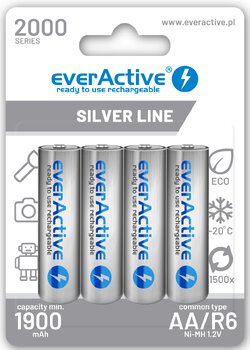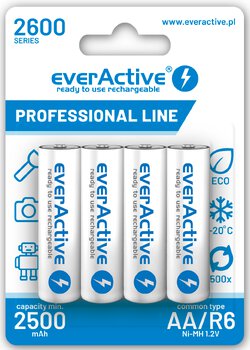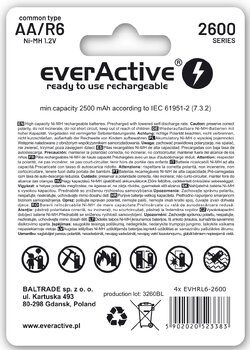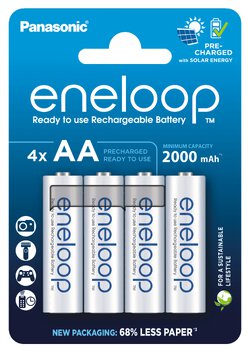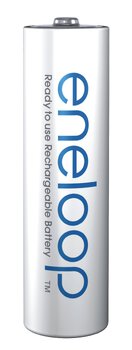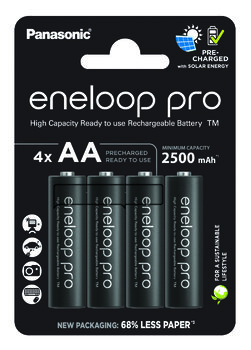- Tips
- technology
- Frequently Asked Questions
- Tests
- mAh capacity
- Rated Capacity
- comparison
- everActive
- Batteries vs rechargeable batteries
- Durability of rechargeable batteries
- Efficiency of rechargeable batteries
- battery voltage
- Accumulated energy
- LR03 AAA
- LR6 AA
- eneloop
- AG13 LR1154 LR44
- CR 2032
- Delta V
- Charge Cycles
- internal resistance
- charge level
- memory effect
- accredited test
- SR44 357
- Hearing Batteries 675
- SR626 377
- Watch Batteries
- Polarity
- Mah
- passivation
- LS 14250
- LS 14500
Why do fresh Ni-MH rechargeable batteries not work in my device or work much worse than disposable batteries?
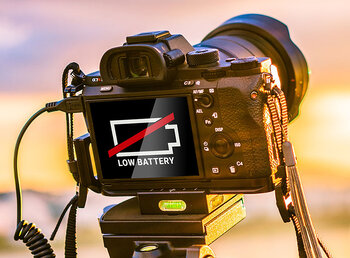
More and more users, following the trend of environmentally friendly solutions, decide to replace disposable batteries, in particular the so-called AA/AAA "sticks" with rechargeable batteries that can be recharged multiple times.
We buy branded, capacious Ni-MH batteries, invest in a good charger, and yet not all our household appliances work properly with the new power source. What is the cause, what to pay attention to? We invite you to read our practical guide.
Before reading this article, it is worth going back to our previous posts "What are the differences between a 1.2V Ni-MH rechargeable battery and a 1.5V alkaline battery?" and "Batteries or rechargeable batteries - the choice depends on the device!”
As you know from our publications, the vast majority of devices tolerate very well and work with Ni-MH batteries without any problems. These rechargeable batteries offer a similar voltage during operation and are compatible with the size of typical batteries.
In very rare cases, however, it happens that the devices do not work properly with Ni-MH batteries and even do not want to start.
Below we describe the most typical scenarios when even fresh batteries do not work very effectively.
In addition to the specific situations described below, in order to ensure maximum reliability of freshly installed batteries, we should:
- charge them before the first use - even if they are completely new "ready to use" batteries, equalizing the charge level before use helps to avoid later problems with too deep discharge and rapid degradation of fresh cells,
- avoid mixing different rechargeable batteries with different levels of charge in the device,
- remember that the voltage on rechargeable batteries decreases with storage - Ni-MH rechargeable batteries have the best discharge characteristics (they offer the highest output voltage) when they are in use after a few hours from removing them from the charger,
- remember that with the passage of time, batteries age, regardless of the conditions of their use - after a few years, any Ni-MH battery with significantly increased resistance will operate very unpredictably and can cause numerous problems.
For the purposes of this article, we will divide the problems of devices with battery support into the following cases:
1) the device does not start on Ni-MH batteries, even immediately after charging:
- regardless of the required power consumption.
2) the device works on Ni-MH rechargeable batteries for a much shorter time than on 1.5V disposable alkaline batteries:
a) in devices with low power consumption, where batteries usually last many weeks between replacements, such as selected LED lamps, the simplest flashlights, clocks, weather stations, thermometers, etc.
b) in devices with high (also impulse-instantaneous) current consumption, such as some wireless thermometers, blood pressure monitors, insulin pumps, powerful LED flashlights, gas igniters in "Junkers" stoves,
1) The rechargeable batteries do not allow you to start your device at all, or the device starts for literally a second - even immediately after removing the batteries from the charger.
Here, by far the most common cause is the lack of contact between the battery in the power compartment of our device.
Rechargeable batteries are finished differently from disposable batteries, especially on the side of the positive terminal. It happens that the "tip" of the battery simply does not touch the metal plate or spring in the chamber of our device.
An example of the current one, in connection with the COVID-19 pandemic, are popular pulse oximeters and touchless soap dispensers, where the "plus" of the battery perfectly falls into the middle of the pressure spring used, with no chance of a good connection.
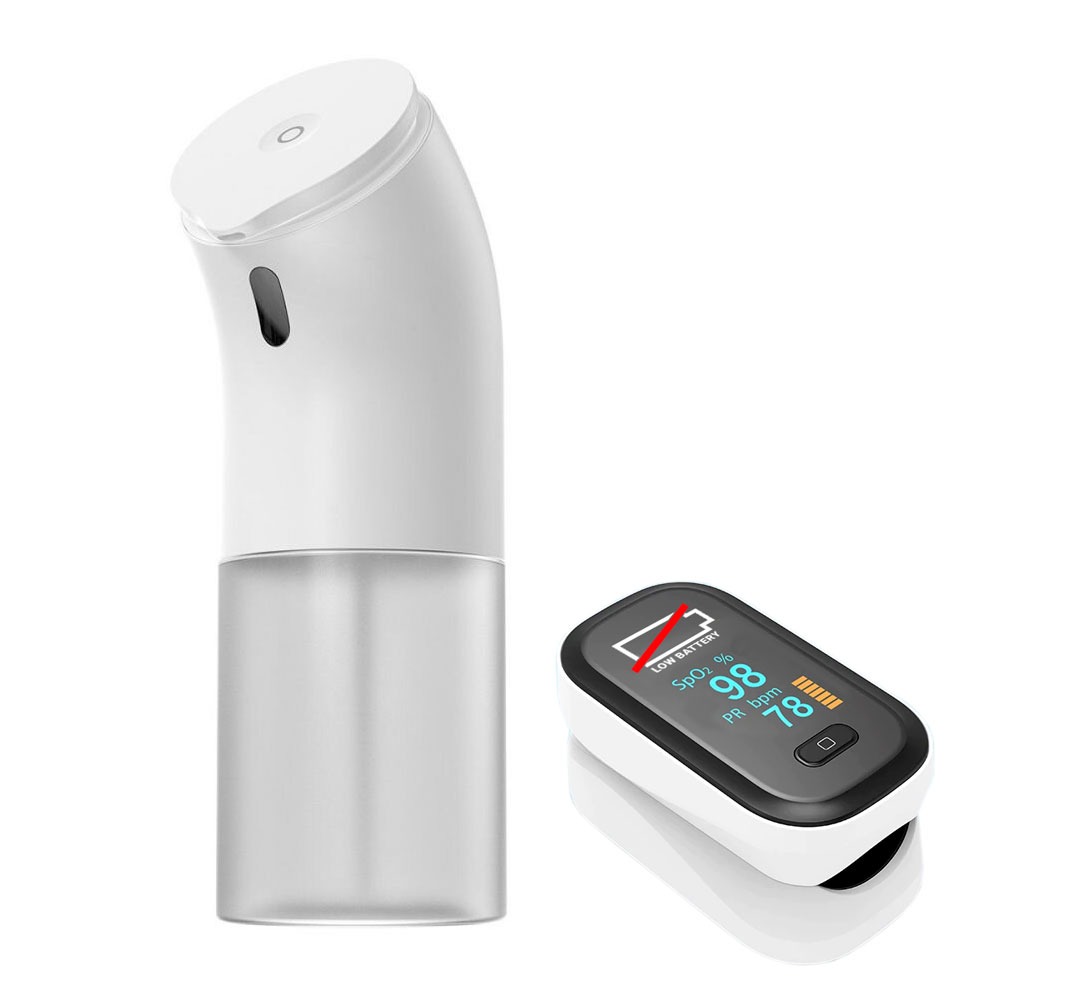
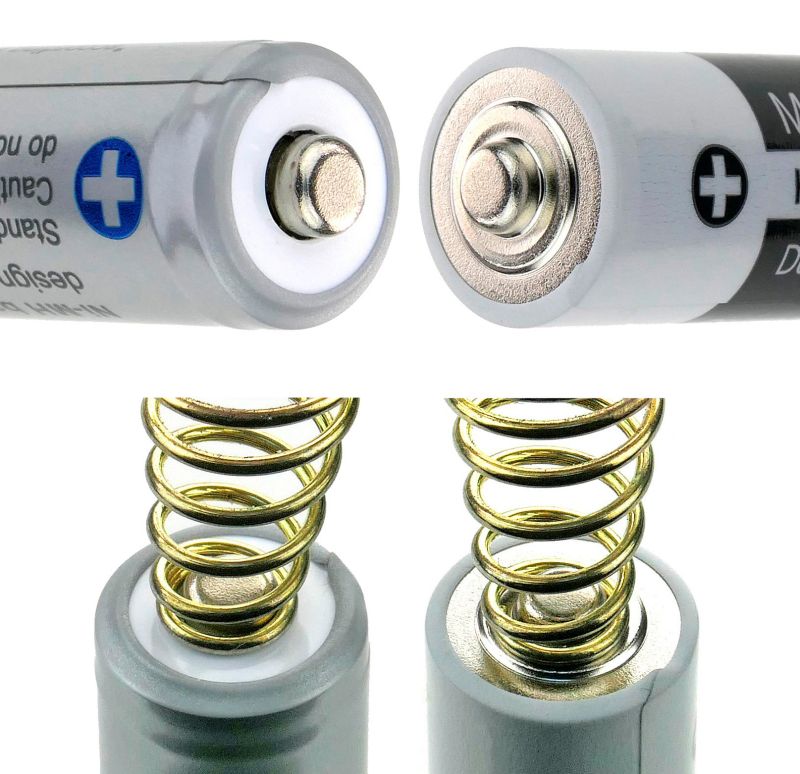
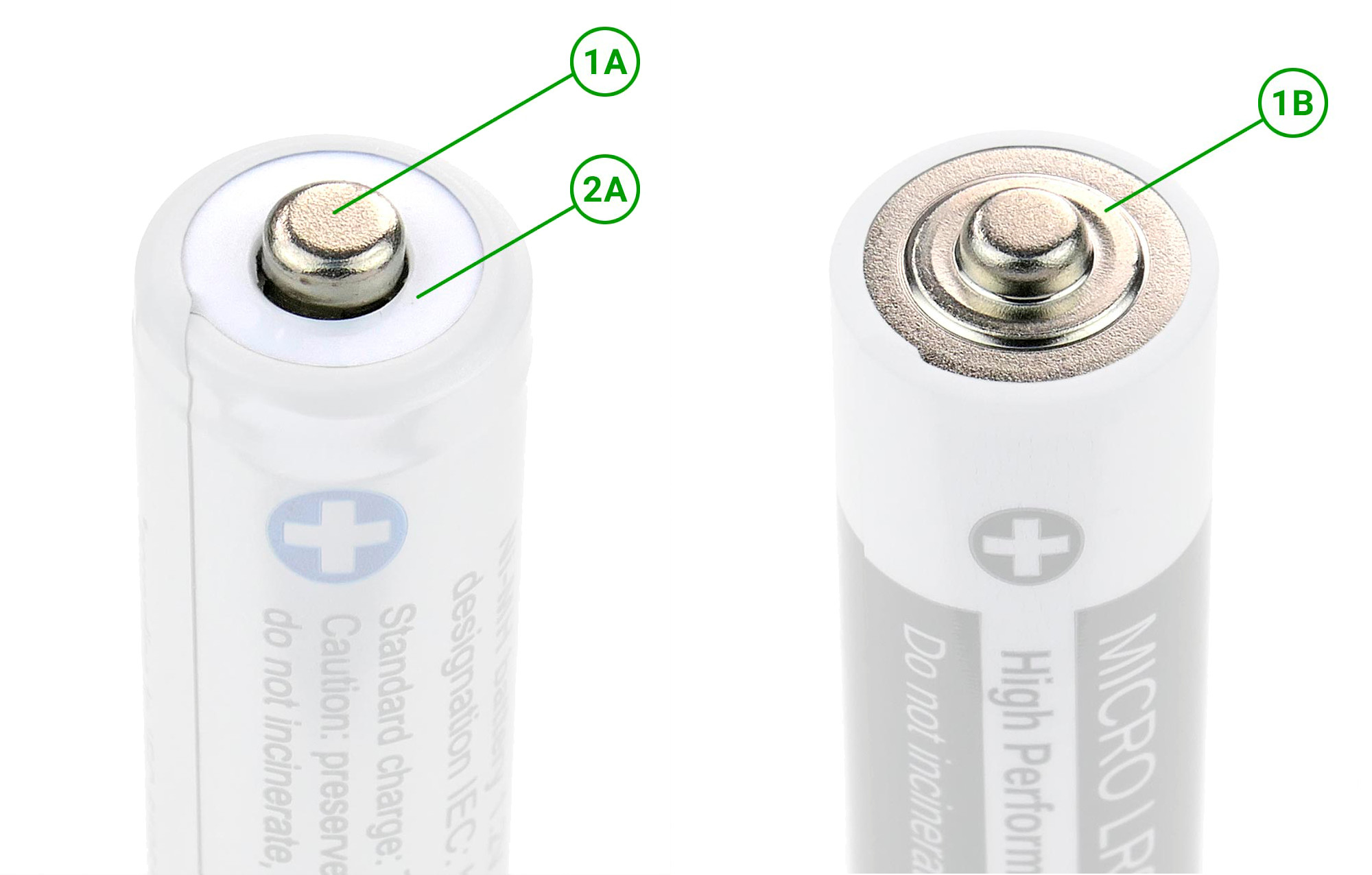
In such situations, the basic activity is to visually assess whether a given battery has a chance to touch the metal clamps in the power supply chamber of our equipment.
Remember that Ni-MH batteries have a different structure from the side of the positive pole - as we show in the photo, only the surface marked as 1A conducts electricity, while 2A is an insulator. Our contact in the device must touch the protruding element 1A, otherwise the device may not even turn on.
Alkaline batteries in this case have a large larger contact surface, marked in the photo as 1B.
If, despite good contact, the device still does not start, it remains to assess whether we have properly charged batteries.
If the battery voltage during installation exceeds 1.30V, and the battery itself is no longer heavily exploited (several years old or one with a highly increased internal resistance), then each device should start at least for a while.
2) Our device starts, but works much shorter on batteries.
a) Equipment with low power consumption.
This is the only scenario where an alkaline battery actually has a certain advantage and offers a higher operating voltage than Ni-MH batteries, thus allowing some devices to work more efficiently.
In undemanding devices, even the most capacious Ni-MH battery will have a lower maximum capacity than a good alkaline battery - the capacity of alkaline batteries, measured under very low load conditions (approx. 5 mA and below) for the LR03 AAA size can be approx. 1400 mAh and 3000 mAh for LR6 AA.
However, it happens that the batteries last much shorter than it results from the difference in capacity itself.
In an unfortunate device, it happens that the battery refuses to work when its voltage drops to about 1.25V or even 1.30V. In devices with low power consumption, a drop in the voltage of an alkaline battery to such a level usually still means a suboptimal discharge of such a battery, about 60-70%. Despite being incompletely discharged, such batteries often last in the device for many months. The average operating voltage of an alkaline battery in such devices can be about 1.40V.
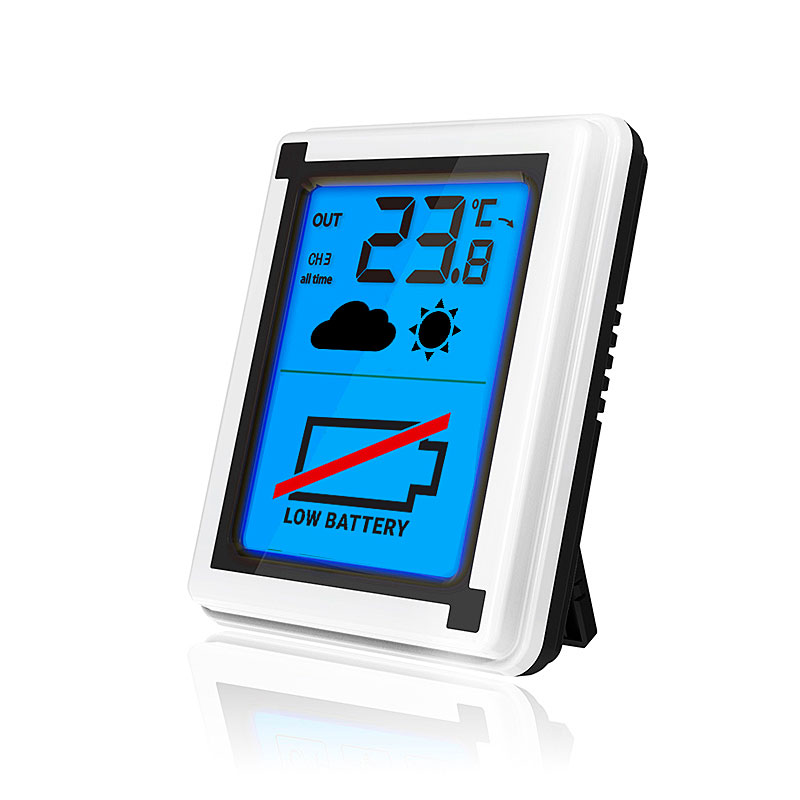

A typical Ni-MH battery, regardless of the discharge conditions, offers an average operating voltage of approx. 1.20V-1.25V, while the voltage of 1.40V is observed only for a moment after disconnecting the charge and in the target device it drops very quickly below the value of 1.30V. In a device that considers such a voltage too low, the batteries will simply refuse to cooperate, even though they will still remain 80-90% charged.
This is quite a rare situation, because there are fewer and fewer devices on the market that waste the energy left in batteries - but if we come across such a device, unfortunately, we have to accept the fact that even disposable batteries will not be optimally used there, and Ni-MH rechargeable batteries will refuse to work much prematurely.
A higher average voltage of alkaline batteries in such a scenario also often causes, for example, a more vivid (contrasting) display of the content of LCD displays (e.g. in electronic watches, weather stations, etc.).
Regardless of the above-mentioned rare cases of "incompatibility" of devices with Ni-MH batteries, remember that nickel-metal hydride batteries are not recommended for use in devices with very low power consumption. This is due to their characteristics and the fact that they also age when they are not used. On such "lazily" used batteries, the so-called lazy battery effect may appear, which we write about in another article. The internal resistance is increased, and the battery itself can cause problems when trying to recharge it.
The use of Ni-MH rechargeable batteries in devices where ordinary disposable batteries last for many months does not bring economic or ecological benefits.
2) Our device starts, but works much shorter on batteries.
b) Equipment with high current consumption.
Ni-MH batteries will always work more efficiently than alkaline batteries in such operating conditions, offering higher capacity as well as higher average operating voltage.
Despite this, it happens that some devices still do not tolerate batteries well, prematurely signaling their discharge. This time the operating voltage does not matter much, but the way the device checks the "capabilities" of the battery.
A device that has been designed specifically for alkaline batteries, in particular a medical device such as a blood pressure monitor, must be highly reliable and return reproducible results. As you know from our other articles, the internal resistance of one alkaline battery is about 4-5 times higher than that of a Ni-MH battery - this means that with high current consumption, a voltage drop will be several times higher on a disposable battery than on a Ni-MH battery, which can make the operation of the entire device unstable and very unreliable.


One of the simple ideas on how to guarantee reliability and repeatability in such conditions is to determine the appropriate voltage "reserve" that must be detected before the compressor starts working in the pressure gauge, etc.
As a result, a device that detects a starting voltage of approx. 1.25-1.30V may not be sure whether the voltage will not drop too low under the target load (even to 1.0V or below) on a typical disposable battery - so to be sure, it suggests replacing the battery. Ni-MH batteries give off high current efficiently (without a noticeable voltage drop under load) also when their voltage drops below 1.30V, so technically there would be no obstacles for them to continue working in such a device - but in such a situation they may not even start, even though they will still be 80-90% charged. The situation is similar in the case of some detonators in gas stoves.
As in the previous scenario, such devices inefficiently use the energy stored even in disposable batteries, and thus cause major problems with Ni-MH batteries. Fortunately, there are also fewer and fewer devices of this type on the market.
Another reason for the shorter (although usually slightly) working time of Ni-MH batteries, e.g. in toys, powerful flashlights, etc. is the fact that rechargeable batteries can give off more power than a typical alkaline battery - for example, an LED headlight shines brighter, but shorter on rechargeable batteries, or a remote-controlled car drives faster, but not so long.
Of course, in this scenario, as in any other, we should also make sure that the batteries are in correct contact with the springs, pressures in the power chamber of our device - contrary to appearances, this is a fairly common and often ignored problem that can be easily tracked down and eliminated.
3. Why does the manufacturer not recommend or even prohibit the use of Ni-MH rechargeable batteries?
The problem affects a very small group of devices. Most often these are devices with high power consumption, so it would seem that rechargeable batteries should be a better choice.
There can be two reasons for this. The manufacturer knows in advance that the mechanism of detecting "weak" batteries will work properly only with alkaline batteries and his device will quickly refuse to work on Ni-MH batteries according to scenario 2b.
More often, however, the problem is not too low starting voltage, but too high average operating voltage of Ni-MH batteries. Simple devices, where the current consumption is limited only by a simple resistor, are calculated for a specific power source for a specific operating voltage. Ni-MH batteries, due to their much lower internal resistance, have a significantly higher operating voltage than alkaline batteries in such applications.


With the use of such a simple "regulator" based on a resistor, it will translate directly into higher current consumption by such a device and "force" it to work with higher power. It would seem that in many cases the effect will be positive - e.g. a more lively motor, a stronger LED flashlight, etc.
Unfortunately, in some cases, if the manufacturer did not provide for the use of rechargeable batteries, the electronic components may overheat and be destroyed, and consequently the entire device.
As in the case of other situations, such devices are currently a rarity on the market.
We hope that this article describes as simply and comprehensively as possible the possible reasons for poor cooperation of devices with rechargeable batteries.
If you have a device that does not fit into any of the described scenarios and still causes problems with batteries, we encourage you to leave a comment - we will try to solve every puzzle.
Author: Michał Seredziński
Copying the content of the text or its part without the consent of a representative of Baltrade sp. z o.o. is prohibited.
You can buy popular rechargeable batteries in the hurt.com.pl store
4x everActive R6/AA Ni-MH 2000 mAh ready to use "Silver line"
4x everActive R6/AA Ni-MH 2600 mAh ready to use "Professional line"
4 x Panasonic Eneloop Ni-MH 2000mAh BK-3MCDE/4BE rechargeable batteries (blister)
New - improved MCDE series
Higher capacity min. 2000 mAh
New eco-friendly packaging for storing rechargeable batteries
- up to 2100 charging cycles
- retains 70% of energy after 10 years after charging!
- works at low temperatures down to -20°C. C!
- charged in the production process with solar energy
Made in Japan
4 x Panasonic Eneloop PRO NEW Ni-MH 2500mAh batteries R6 / AA BK-3HCDE/4BE (blister)
New improved HCDE series
New eco-friendly packaging for storing rechargeable batteries
- the highest capacity among the new generation of 2500 mAh rechargeable batteries
- retains 85% of energy after 12 months after charging!
- works at low temperatures down to -20°C. C!
- charged in the production process with solar energy
Made in Japan
-
Od 8 lat używam akumulatorków wszędzie gdzie się da. Kilka wypadło, ale dzięki odpowiednej ładowarce przywrócone do działania. Przetestowałem mnóstwo aku z niemal wszystkich firm. Jest ich sporo. Z doświadczenia wiem, że najlepiej spisały i spisują się aku seri 'Eneloop" firmy Sanyo, zwłaszcza te o wydłużonym utrzymaniu naładowania. Wszelkie aku Recyko, Infinity zawiodły mnie. Nie mają tej klasy. Zdały też egzamin tańsze Kodaki, które używam w domowych lampkach z czujnikiem ruchu. Badziew chiński omijam z daleka. Ładowarka musi być dobra, a nie tani szajs. Ładowarka musi regenerować aku, resetować i odnawiać, musi wskazywać poziom naładowania etc. Większość z posiadanych aku zakupiłem właśnie w hurt.com.
-
Świetny artykuł! Bardzo wiele przydatnych informacji. Dziękuję! :)
